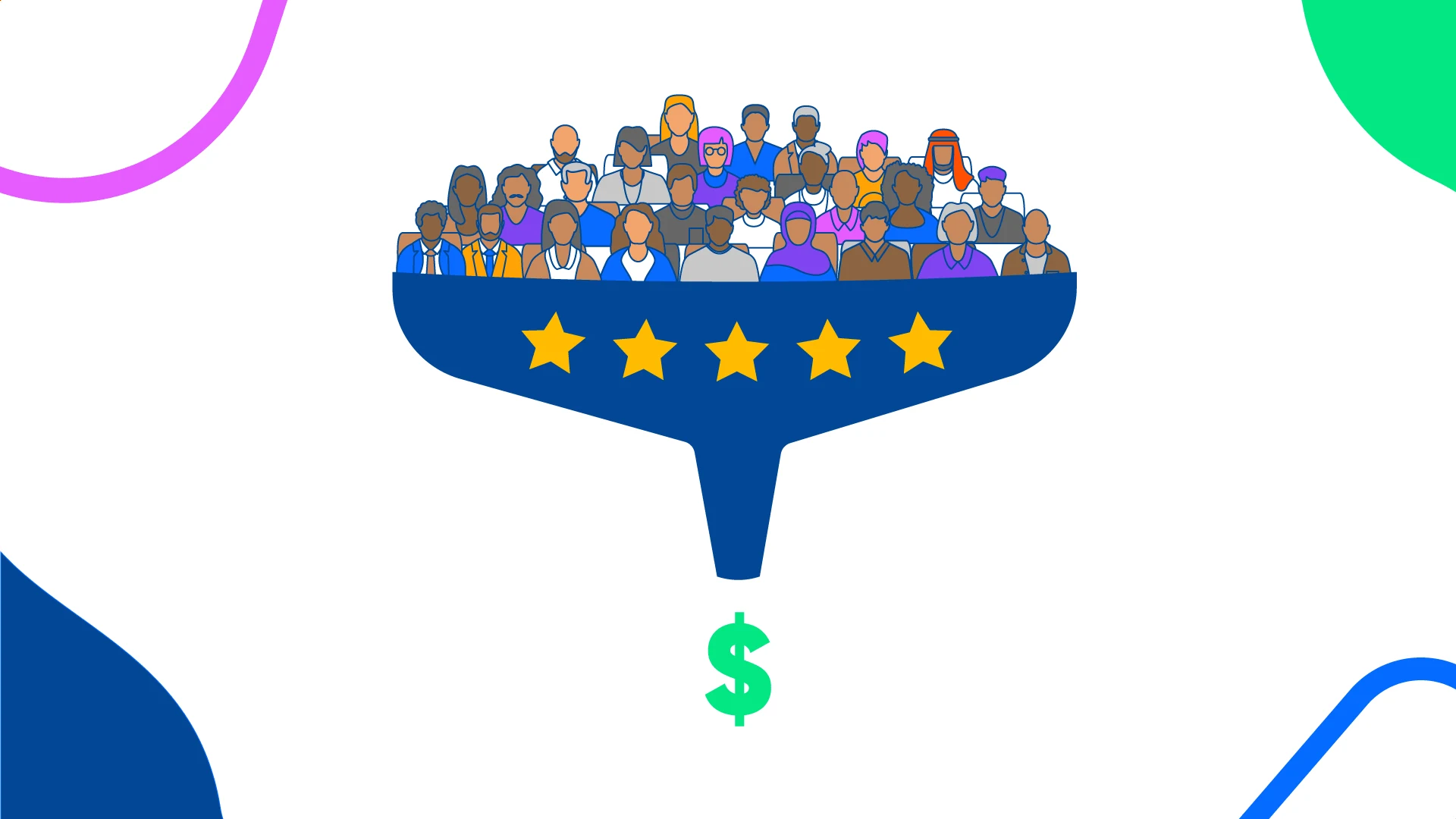Sales
Lead qualification: How to improve lead qualification and quality
Prioritize valuable leads, speed up your sales cycle, and close more deals with lead qualification.
Rachel Burns
Jun 22, 2023
15 min read
Table of contents
What is lead qualification?
Your sales team's time is valuable — what if you could guarantee they spend it on high-quality prospects, not unqualified leads?
That's where lead qualification comes into play.
With an effective lead qualification process, your team can focus on the most promising leads, speed up the sales cycle, and close more deals.
In this blog post, we'll walk through the ins and outs of lead qualification. We'll cover the benefits, types of leads and frameworks, and how to set up your own lead qualification processes. We’ll also explore the power of scheduling automation in simplifying the lead qualification process.
Key takeaways:
Lead qualification speeds up the sales cycle, aligns sales and marketing efforts, drives ROI, and helps sales teams save time and resources by prioritizing the leads most likely to convert.
To qualify leads effectively, gather data beyond contact information — you need to understand the lead's needs, preferences, budget, timeline, and decision-making authority.
Popular lead qualification frameworks include BANT, GPCTBA/C&I, CHAMP, MEDDIC, and ANUM, each with its own pros and cons.
Scheduling automation speeds up the lead qualification process by instantly qualifying and booking high-value leads. Create a seamless handoff from marketing to sales and give your team time to focus on high-value prospects, so they can close more deals.
6 benefits of lead qualification
Here are six reasons why you should make lead qualification part of your sales strategy:
Identify more qualified leads: When you put lead qualification processes in place, you establish criteria and methods to assess potential customers based on how likely they are to make a purchase. Using these processes to identify more qualified leads means closing more deals.
Save time and resources: Lead qualification helps sales teams prioritize leads with a high chance of converting, so you don’t spend valuable time on leads that aren’t a good fit.
Speed up your sales cycle: By identifying leads who are ready to buy or close to making a purchase decision, you can engage with them at the right time and guide them towards a successful sale faster. This speeds up your sales cycle, so you can close more deals in less time.
Better understand your customers/learn more about your target audience: Clearly defining your ideal customers' characteristics, demographics, and needs helps you proactively seek out leads that fit your ideal customer profile (ICP). This helps you target the right people with your marketing and sales efforts.
Align sales and marketing efforts: Lead qualification ensures a smoother handoff from marketing to sales. When everyone agrees on what makes an ideal customer, your marketing team can generate more high-quality leads for the sales team to close.
See more ROI on your lead generation campaigns and sales efforts: Focusing on the leads most likely to convert helps sales teams optimize their efforts, leading to higher conversion rates and revenue. You can allocate resources more effectively, so teams don't waste marketing budget or sales reps' time on unqualified leads.
“We use lead qualification to ensure the right leads are getting to our sales team, with the right message, at the right time.”
Koryn DelPrince
Manager, Lifecycle Marketing at Calendly
Types of qualified leads
As you learn more about lead qualification frameworks and processes, you’ll hear different types of leads referred to with a variety of terms and acronyms. Here are some of the most common types of qualified leads.
Information qualified leads (IQLs): These leads are in the early stage of the buyer’s journey and haven’t yet shown much interest or engagement. For example, an IQL visits your website and views a few pages but doesn’t download gated content or sign up to learn more. IQLs are sometimes called cold leads.
Product qualified leads (PQLs): PQLs have already experienced your product in some way and have shown interest in buying or upgrading. If you offer a free trial, a PQL might be someone who uses your product every day and explores different features during the trial period.
Marketing qualified leads (MQLs): These leads have engaged with your marketing. An MQL could be someone who downloaded a whitepaper or ebook from your website, showing interest in a particular topic related to your product. MQLs are sometimes called warm leads.
Sales qualified leads (SQLs): These leads have shown more interest, are a better fit for your product, and are ready to buy soon. For example, a lead who requests a demo, engages with your sales emails, and requests a pricing quote is an SQL. SQLs are sometimes called hot leads.
The lead qualification process
So, how do you actually go about qualifying sales leads? Every organization’s lead qualification process varies depending on your needs and goals, but here are some common steps to help you get started.
1. Establish your ideal customer profile (ICP). To know whether a lead fits your ideal buyer persona, you first have to define your ICP. What makes someone a great fit for your product? What are some telltale signs they're ready to buy (and have the authority and budget to do so)? Your ICP should include job titles, company size and industry, location, demographics, pain points, and existing tech stack. Depending on your product, you may have multiple ICPs in different industries.
Knowing your ICP also helps align marketing and sales — your marketing team can target the right audience with the right messaging, so they fill your pipeline with qualified leads for sales to convert.
2. Choose a lead qualification framework. A lead qualification framework provides a structured way to assess a lead’s goals, challenges, budget, authority, and more. Popular frameworks include BANT, GPCTBA/C&I, CHAMP, MEDDIC, and ANUM. We’ll dive into the pros and cons of each framework in a moment.
3. Set up lead scoring. Lead scoring lets you quantify how engaged and qualified a lead is as they move through the buyer’s journey. You can identify and track the most promising leads by assigning values to actions like website visits, content downloads, demo bookings, or email interactions. Sales and marketing automation tools like Salesforce, Marketo, and ActiveCampaign simplify lead scoring setup and monitoring.
4. Gather data: Use your marketing forms to collect more than just contact information — you need to understand prospects’ needs, preferences, budget, timeline, and decision-making authority. Asking all those questions up front would make for a pretty cumbersome form, and long-form answers are time-consuming for your team to read and analyze.
Luckily, you already established your ICP, so you know what job titles, industries, and company sizes tend to make a good lead. Using dropdown menus to collect that info provides valuable insights for lead qualification without overwhelming the prospect.
You can also use a data enrichment tool like Clearbit to gather additional details about a prospect and their company based on limited information like their name, email, or phone number. Clearbit can also hide form fields when you already have a piece of customer info, shortening the forms for a better user experience.
5. Evaluate, segment, and prioritize leads: Based on a lead’s information and behavior, you can start to determine indications of interest, fit, and readiness to move forward. From there, segment leads based on where they are in the buyer’s journey, then prioritize the most qualified leads for your sales reps. Lead scoring and tracking through a platform like Salesforce or Marketo can automate this step.
6. Nurture qualified leads: Once you've identified qualified leads, nurture them with tailored content, personalized interactions, and targeted messaging. Develop effective sales strategies to guide them through the buying process, addressing their specific pain points and showcasing the value of your solution.
7. Continuously measure and iterate on your processes: The lead qualification process isn’t set in stone. Continuously evaluate and refine your processes based on feedback and results. Is your sales team talking to more qualified leads, or are unqualified prospects still consuming reps’ time? Make adjustments as you learn more about your customers and processes.
Qualify, route, and book sales meetings instantly
Lead qualification examples
Newsletter subscribers
Alex, a business owner, visits Acme Inc.’s website and signs up for their biweekly email newsletter. During the next couple of months, Alex gets valuable insights and learns about the benefits of Acme Inc.’s software. Acme Inc. tracks Alex's interactions with each newsletter. They monitor when Alex opens the emails, clicks on links, or forwards the newsletter to coworkers.
Based on Alex's engagement, Acme Inc. assigns a lead score to measure his level of interest and engagement. For example, opening multiple emails, signing up for product-related webinars, or downloading additional resources can all increase Alex's lead score. At this point, Alex is an MQL.
Once Alex's lead score reaches a certain threshold, a sales rep from Acme Inc. reaches out to Alex via email. The rep embeds their meeting availability in an email, making it easy for Alex to book a sales discovery call. During the call, the sales rep asks Alex questions to better understand his team’s needs and challenges. If Alex’s team is a good fit for Acme Inc.’s product, he becomes an SQL.
Event attendees
Let's say Acme Inc. has a booth at an industry conference. Conference attendees who visit the booth, attend a product demo, or swap business cards with an Acme Inc. sales rep can be considered MQLs. Engagement with post-event follow-ups, like personalized email sequences, helps Acme Inc.’s sales team determine which attendees should be invited to sales discovery calls.
How Calendly uses lead scoring in our lead qualification process
At Calendly, we use lead scoring to determine which leads should be passed to the sales team. Here’s how it works:
A lead fills out a form on the landing page for a piece of gated content, requests a demo, or fills out a “contact us” form.
The lead enters Marketo, which we use for lead nurture and scoring.
Depending on the lead’s industry, title, and other characteristics, they receive nurture emails with content that relates to their interests and needs.
The lead scores points based on activities like replying to a sales email or booking a meeting.
When the lead hits a score of 100, they’re sent to the sales team to book a meeting.
Once they’re qualified by a sales rep, they become a sales-qualified opportunity (SQO).
“We use automation to move leads through different sales funnel stages based on activities like replying directly to a sales email or booking a meeting,” says Sarah Jackson, Calendly’s Senior Manager of Revenue Operations. “This process helps our sales team focus on leads that we know are most likely to convert.”
“Our lead qualification processes are critical for getting the right customers in front of sales quickly.”
Sarah Jackson
Senior Manager, Revenue Operations at Calendly
Common lead qualification frameworks
Lead qualification frameworks provide structured approaches to assessing and prioritizing leads based on factors like needs, pain points, budget, authority, and timeline. Keep in mind that there’s no one-size-fits-all framework. Your team can adapt and customize these frameworks to align with your target audience, objectives, and sales processes.
Here are five of the most popular lead qualification frameworks and the pros and cons of each.
1. BANT (Budget, Authority, Needs, Timeline)
What is BANT? IBM developed the BANT framework to determine if a lead has the financial resources, decision-making power, and immediate need for your product. A prospect should meet at least three criteria to be considered qualified.
Pros: BANT is straightforward to use and widely recognized across industries.
Cons: BANT has been criticized for being too focused on traditional criteria and oversimplifying lead qualification without leaving much room for nuance.
2. GPCTBA/C&I (Goals, Plans, Challenges, Timeline, Budget, Authority, Consequences, Implications)
What is GPCTBA/C&I? The GPCTBA/C&I framework evaluates the lead’s goals, plans, challenges, timeline, budget, decision-making authority, consequences of inaction, and implications of choosing your solution. This framework gives sales teams detailed insights into each lead, so reps can pinpoint your product’s fit and potential impact.
Pros: GPCTBA/C&I is a more comprehensive approach, providing a holistic view of the lead’s situation for a more personalized sales strategy.
Cons: GPCTBA/C&I requires more in-depth information gathering and analysis of each lead, which can be time-consuming.
3. CHAMP (CHallenges, Authority, Money, Priority)
What is CHAMP? The CHAMP framework focuses on four key elements for lead qualification: the lead's challenges, decision-making authority, financial resources, and the priority level or urgency of their needs.
Pros: CHAMP is a straightforward framework that lets sales teams move quickly.
Cons: CHAMP’s simplicity means teams may overlook aspects like decision-making processes, timeframes, and the implications of choosing your product.
4. MEDDIC (Metrics, Economic Buyer, Decision Criteria, Decision Process, Identify Pain, Champion)
What is MEDDIC? MEDDIC involves identifying metrics (the economic benefits of your solution), the economic buyer (the decision maker), decision criteria, the decision process, pain points, and your product’s champion within the organization.
Pros: MEDDIC is a comprehensive, structured approach to help sales teams make informed decisions.
Cons: The MEDDIC framework is more complex and requires a deeper understanding of the lead’s organization and processes. For MEDDIC to work, leads must be willing to share that information with your team.
5. ANUM (Authority, Need, Urgency, Money)
What is ANUM? ANUM involves determining the lead’s decision-making authority, their needs, the urgency of those needs, and their budget.
Pros: ANUM is a quick and straightforward way to assess basic qualification factors and prioritize leads accordingly.
Cons: Like CHAMP and BANT, ANUM may oversimplify qualification and overlook important factors like decision-making processes or the solution’s broader implications.
How scheduling automation simplifies the lead qualification process
A long sales cycle is a pain point for salespeople across industries. The median B2B sales cycle length is 2.1 months! When you make scheduling automation part of your lead qualification process, time-consuming tasks like manual lead qualification and assignment won’t slow down the buyer’s journey or disrupt deals.
Sales teams that contact potential customers within an hour of receiving a query were nearly seven times as likely to qualify the lead vs. sales teams that tried to contact the lead an hour later.
Your scheduling automation platform can be an excellent demand gen tool. With Calendly Routing, instantly qualify leads from your website’s marketing forms, then automatically route them to a booking page based on their responses. Show scheduling pages only to leads who meet your qualifications, like prospects from specific industries or companies of a certain size. That way, your busy team can spend valuable time on the deals that matter most.
Calendly Routing works with HubSpot, Marketo, Pardot and Calendly forms, so you can create a seamless handoff from marketing to sales — and no high-value prospects slip through the cracks. And when you integrate Calendly with Salesforce, you can send known leads or customers from your website form directly to their account owner’s booking page. No one has to spend valuable time manually reassigning leads.
“The Salesforce lookup is a game changer for our sales team. They no longer spend 5+ hours a month reassigning website demos.”
Abbie Deaver
Director of Marketing at RCReports
If your marketing forms use visible and hidden form field responses to qualify leads and surface specific booking pages, you can also use that data to determine which booking pages appear. That means you can continue to take advantage of data enrichment tools, like Clearbit or ZoomInfo, to shorten your HubSpot and Marketo forms.
What happens if a lead doesn’t qualify for a meeting? Instead of sending them to a booking page, you can display a custom message with next steps, ask them for more information, or redirect them to a specific URL, like a piece of gated content or a webinar signup page.
What does this look like in action?
Let’s say your sales pipeline goal is to land meetings with qualified leads like Nora, an IT buyer at an enterprise software company. Nora fills out your “contact sales” form, which is already built in HubSpot, connected to Calendly Routing, and enriched with Clearbit.
Nora enters her email address in the form, and Clearbit fills in the company name, size, and industry. This shortens the form so Nora only has to input her name and job title. Based on Nora’s information — company size, industry, department, job title — she’s a highly qualified lead, so you automatically route her to the booking page for your best sales rep. Nora is happy about that, and immediately books the meeting time that works for her, with the exact person she needs to talk to.
“A good tool is one that’s so simple, sales reps can basically forget about it and let the meetings roll in. That’s essentially what happened when we implemented Calendly.”
Julia Pan
Sales Enablement Manager at SignPost
Start exploring what Calendly can do for your team. Sign up for a free 14-day trial of all Teams features, including lead routing.
Lead qualification checklist
Before we wrap up, here’s a checklist of qualifying questions your team can use when assessing prospects, whether via marketing forms, sales emails, or discovery calls. (These questions are written with B2B sales teams in mind, but can be adapted to fit any ICP.)
What are the biggest challenges facing your business right now?
What goals are you looking to achieve with [your type of product]?
What’s your budget for this project?
Have you used similar products in the past? What were the results?
Who are the key decision-makers involved in a purchase like this?
What is your timeline for making a decision and implementing a solution?
Are there any specific features that are must-haves for your business?
Are you currently evaluating other options? If so, what factors are influencing your decision?
By asking these qualifying questions, your team can gain valuable insights into the lead’s pain points, readiness to move forward, and how well your product fits their needs — so you can identify and prioritize the most promising leads in your pipeline.
Better lead qualification, better results
Lead qualification helps sales teams prioritize the right leads, speed up the sales process, and close more deals. To make the most of your lead qualification process, you need to gather information about your leads’ budget, needs, decision-making timeline, and authority.
Scheduling automation tools like Calendly can make the lead qualification process easier and faster for your team. Instantly qualify and book high-value leads, so you can focus on the prospects most likely to convert and stop valuable leads from slipping through the cracks.
Ready to take your lead qualification processes to the next level? Get in touch with our sales team today.
Get started with Calendly
Ready to make scheduling easier than ever?
Rachel Burns
Rachel is a Content Marketing Manager at Calendly. When she’s not writing, you can find her rescuing dogs, baking something, or extolling the virtue of the Oxford comma.
Related Articles
Don't leave your prospects, customers, and candidates waiting
Calendly eliminates the scheduling back and forth and helps you hit goals faster. Get started in seconds.
Calendly eliminates the scheduling back and forth and helps you hit goals faster. Get started in seconds.






